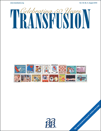Identification of specificities of antibodies against human leukocyte antigens in blood donors
This work was supported by NHLBI Contracts N01-HB-47168, -47169, -47170, -47171, -47172, -47175, and -57181.
Abstract
BACKGROUND: Transfusion-related acute lung injury (TRALI) is the leading cause of transfusion-related mortality. Blood centers are implementing TRALI risk reduction strategies based on screening apheresis donors for antibodies to human leukocyte antigens (HLA).
STUDY DESIGN AND METHODS: HLA antibody screening was performed on 7920 blood donors from the Leukocyte Antibody Prevalence Study (LAPS) using Luminex-based normalized background (NBG) cutoff ratios of 10.8 (Class I) and 6.9 (Class II). Single antigen bead (SAB) assay cutoffs of 2500 median fluorescence intensity units (Class I) and 1500 (Class II) were established based on results of two subpopulations of LAPS donors. Antibody frequencies against HLA A, B, C, DR, DQ, and DP antigens were determined for screen-reactive donors with prior pregnancies.
RESULTS: SAB reactivity for samples above our multiantigen bead NBG cutoffs was 78% for Class I and 79% for Class II. The SAB-positive rate increased among women with zero to four or more pregnancies (0.3%-15.6% Class I and 0.4%-18% Class II; p < 0.00001). The highest frequency antibodies were DR11 and B15 (4.4% of women with prior pregnancies). The majority of Class I positives contained more than five specificities. For Class II, antibody-positive women segregated into two groups: a single specificity or more than five specificities.
CONCLUSIONS: Identification of HLA antigen specificities supports pregnancy associations previously found with screening assays. The significance of particular HLA specificities for inducing TRALI is currently being evaluated in a large lookback study of recipients of high-plasma-volume components from this donor cohort.




